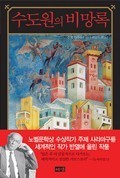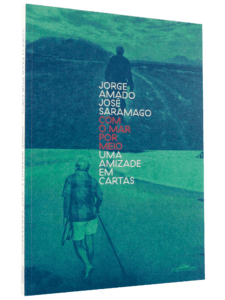Convent memorial

It is a work of fiction about a specific time in the past, but seen from the perspective of the author's present moment, and with everything that the author is and has: his background, his interpretation of the world, the way he understands the process of societal transformation.
Foundation
Awards for the work
1982. Portuguese PEN Club Award. Portugal.
1982. Lisbon Municipality Literary Prize. Portugal.
Portugal

2014 (1st edition by Porto Editora; 54th edition); 2019, 61st edition.
Language
Portuguese
«"An innovative historical novel. The main character is the Mafra Convent. The writer departs from rigid description, favoring the characterization of an era. He follows the style: 'Once upon a time there was a king who made promises to build a convent in Mafra… Once upon a time there were the people who built that convent… Once upon a time there was a one-handed soldier and a woman who had powers… Once upon a time there was a priest who wanted to fly and died mad.' Everything, 'once upon a time…'" Starting with “D. João, the fifth of that name in the royal lineage, will go tonight to the room of his wife, D. Maria Ana Josefa, who arrived more than two years ago from Austria to give heirs to the Portuguese crown and has not yet conceived (...). Then, standing out, is that astonishing character, Blimunda, meeting Baltasar. Blimunda traveled thousands of leagues, and the romance traveled the world, in writing and in opera (in an adaptation by the Italian composer Azio Corghi). For our memory remain these two unforgettable characters, one Seven Suns and the other Seven Moons, strolling through their love in the violent and inquisitorial Portugal of the sad times of King D. João V.” (Diário de Notícias, October 9, 1998)

This was a special edition envisioned by José Saramago.
A unique and limited edition.
Foreword by Prof. Dr. Carlos Reis
20 unpublished illustrations by the painter João Abel Manta
José Saramago, whom I remember with great affection, will be a permanent part of the Western canon. […] His many novels possess a prodigious variety and sensitivity, as well as a versatile scope encompassing tragicomedy and something close to chivalrous romantic quest.
HAROLD BLOOM, TIME
It has been clear since the publication of Memorial do Convento that José Saramago believes that only love makes life bearable.
JULIAN EVANS, THE GUARDIAN

Editorial Path
1982, 53rd ed., 2013
Language
Portuguese
«"An innovative historical novel. The main character is the Mafra Convent. The writer departs from rigid description, favoring the characterization of an era. He follows the style: 'Once upon a time there was a king who made promises to build a convent in Mafra… Once upon a time there were the people who built that convent… Once upon a time there was a one-handed soldier and a woman who had powers… Once upon a time there was a priest who wanted to fly and died mad.' Everything, 'once upon a time…'" Starting with “D. João, the fifth of that name in the royal lineage, will go tonight to the room of his wife, D. Maria Ana Josefa, who arrived more than two years ago from Austria to give heirs to the Portuguese crown and has not yet conceived (...). Then, standing out, is that astonishing character, Blimunda, meeting Baltasar. Blimunda traveled thousands of leagues, and the romance traveled the world, in writing and in opera (in an adaptation by the Italian composer Azio Corghi). For our memory remain these two unforgettable characters, one Seven Suns and the other Seven Moons, strolling through their love in the violent and inquisitorial Portugal of the sad times of King D. João V.” (Diário de Notícias, October 9, 1998)
“"Memorial do Convento" in braille is available for consultation at the José Saramago Foundation headquarters, published by the Directorate-General for Education of the Portuguese Republic.

Editorial Path
1982, 53rd ed., 2013
Language
Portuguese
«"An innovative historical novel. The main character is the Mafra Convent. The writer departs from rigid description, favoring the characterization of an era. He follows the style: 'Once upon a time there was a king who made promises to build a convent in Mafra… Once upon a time there were the people who built that convent… Once upon a time there was a one-handed soldier and a woman who had powers… Once upon a time there was a priest who wanted to fly and died mad.' Everything, 'once upon a time…'" Starting with “D. João, the fifth of that name in the royal lineage, will go tonight to the room of his wife, D. Maria Ana Josefa, who arrived more than two years ago from Austria to give heirs to the Portuguese crown and has not yet conceived (...). Then, standing out, is that astonishing character, Blimunda, meeting Baltasar. Blimunda traveled thousands of leagues, and the romance traveled the world, in writing and in opera (in an adaptation by the Italian composer Azio Corghi). For our memory remain these two unforgettable characters, one Seven Suns and the other Seven Moons, strolling through their love in the violent and inquisitorial Portugal of the sad times of King D. João V.” (Diário de Notícias, October 9, 1998)

Editorial Path
1982, 53rd ed., 2013
Language
Portuguese
«"An innovative historical novel. The main character is the Mafra Convent. The writer departs from rigid description, favoring the characterization of an era. He follows the style: 'Once upon a time there was a king who made promises to build a convent in Mafra… Once upon a time there were the people who built that convent… Once upon a time there was a one-handed soldier and a woman who had powers… Once upon a time there was a priest who wanted to fly and died mad.' Everything, 'once upon a time…'" Starting with “D. João, the fifth of that name in the royal lineage, will go tonight to the room of his wife, D. Maria Ana Josefa, who arrived more than two years ago from Austria to give heirs to the Portuguese crown and has not yet conceived (...). Then, standing out, is that astonishing character, Blimunda, meeting Baltasar. Blimunda traveled thousands of leagues, and the romance traveled the world, in writing and in opera (in an adaptation by the Italian composer Azio Corghi). For our memory remain these two unforgettable characters, one Seven Suns and the other Seven Moons, strolling through their love in the violent and inquisitorial Portugal of the sad times of King D. João V.” (Diário de Notícias, October 9, 1998)

Editorial Path
2002 commemorative edition marking twenty years since the publication of Memorial do Convento (illustrations by José Santa-Bárbara)
Language
Portuguese
Special edition of Memorial do Convento, by José Saramago, commemorating the twentieth anniversary of its first edition in October 1982. It is illustrated with paintings by José Santa-Bárbara, which are part of the cycle "Vontades. Uma leitura de Memorial do Convento" (Desires. A reading of Memorial do Convento).
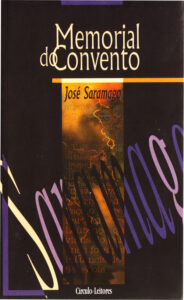
Circle of Readers
1984
Language
Portuguese
Circle of Readers
1984
Albania

“Perëndia dorace” është pa dyshim kryevepra e José Saramagos, vepra më e përkthyer e tij, romani që ka fituar më tepër çmime, mes të cilëve edhe “Çmimin e Madh të Romanit” të Pen Klubit. Vetëm dashuria – dashuria njerëzore – mund ta shpëtojë njeriun, të ndreqë në njëfarë mënyre të metën e universit. And tillë është bindja and thellë and autorit, and cila shpaloset gjatë tërë veprës së tij. Gruaja aty është përherë motori i veprimit dhe mbartësja e kuptimit.
Germany

Das Monument seiner Macht – so König Joãos Streben – soll an Pracht und Größe den spanischen Escorial übertreffen. Dreizehn Jahre dauert die Errichtung des Klosters, die ein Baumeister aus Regensburg begleitet, unzählige Arbeiter schinden sich dabei jämmerlich zu Tode. Saramago stellt den Wahnsinn dieses vermessenen Projekts dem Elend des gequälten Volkes gegenüber, das Trost in Magie und messianischen Erwartungen sucht. In opulenten Bildern lässt Saramago die erste Hälfte des 18. Jahrhunderts in Portugal in all seinen Facetten auferstehen.

1711 verspricht König João V. von Portugal als Dank für sein erstes Kind die Erbauung eines Klosters in Mafra. Aus dem ganzen Land werden Arbeiter herangeschafft, und es beginnen Jahre einer apokalyptischen Schreckenszeit. Mit epischer Wortgewalt erzählt Saramago über den Prunk der Mächtigen, die Gräuel der Inquisition und den Aberglauben des Volkes.Das Monument seiner Macht – so König Joãos Streben – soll an Pracht und Größe den spanischen Escorial übertreffen. Dreizehn Jahre dauert die Errichtung des Klosters, die ein Baumeister aus Regensburg begleitet, unzählige Arbeiter schinden sich dabei jämmerlich zu Tode. Saramago stellt den Wahnsinn dieses vermessenen Projekts dem Elend des gequälten Volkes gegenüber, das Trost in Magie und messianischen Erwartungen sucht. In opulent Bildern lässt Saramago die erste Hälfte des 18. Jahrhunderts in Portugal in all seinen Facetten auferstehen

Der Seefahrernation Portugal gehörte zu Beginn des 18. Jahrhunderts die halbe Welt, während im Mutterland der finstere Geist der Inquisition herrschte. An der Spitze des Reiches stand der pompös lebende König Joao V. Als er die Erbauung eines Klosters in Mafra verspricht, werden Arbeiter aus dem ganzen Land herbeigepreßt, unter ihnen der einhändige Soldat Baltasar, der mit der Seherin Blimunda zusammen lebt. Dreizehn Jahre dauert die Errichtung des Klosters, eine apokalyptische Schreckenszeit …
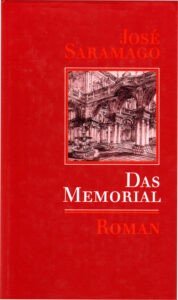
Der Seefahrernation Portugal gehörte zu Beginn des 18. Jahrhunderts die halbe Welt, während im Mutterland der finstere Geist der Inquisition herrschte. An der Spitze des Reiches stand der pompös lebende König Joao V. Als er die Erbauung eines Klosters in Mafra verspricht, werden Arbeiter aus dem ganzen Land herbeigepreßt, unter ihnen der einhändige Soldat Baltasar, der mit der Seherin Blimunda zusammen lebt. Dreizehn Jahre dauert die Errichtung des Klosters, eine apokalyptische Schreckenszeit …
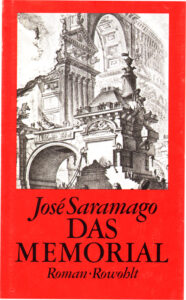
Der Seefahrernation Portugal gehörte zu Beginn des 18. Jahrhunderts die halbe Welt, während im Mutterland der finstere Geist der Inquisition herrschte. An der Spitze des Reiches stand der pompös lebende König Joao V. Als er die Erbauung eines Klosters in Mafra verspricht, werden Arbeiter aus dem ganzen Land herbeigepreßt, unter ihnen der einhändige Soldat Baltasar, der mit der Seherin Blimunda zusammen lebt. Dreizehn Jahre dauert die Errichtung des Klosters, eine apokalyptische Schreckenszeit …

Coron Verlag
1999
Language
German
Coron Verlag
1999

Aufbau-Verlag
1986 (Translated by Andreas Klotsch)
Language
German
Aufbau-Verlag
1986 (Translated by Andreas Klotsch)
Argentina
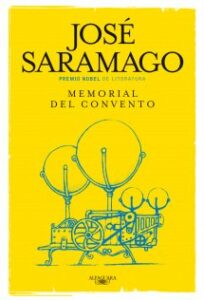
1995; 2010 (José Saramago Library Collection) (Translated by Basilio Losada)
Language
Spanish
One of the most famous texts in Portuguese literature of all time. Once upon a time, a king made the promise to build a convent in Mafra.
Once upon a time, people built this convent.
There was once a lame soldier and a woman who had powers.
It was once the story of love without words of love.
There was once a curate who wanted to fly away and died crazy.
Érase una vez un músico.
Érase una vez una passarola.
Once upon a time, it was erase.
“There are many echoes that this fascinating novel leaves in my memory, but, above all, its love story resonates with the rest of the action like a flute in the middle of a great orchestra.”
The New York Times Book Review

1995; 2010 (José Saramago Library Collection) (Translated by Basilio Losada)
Language
Spanish
One of the most famous texts in Portuguese literature of all time. Once upon a time, a king made the promise to build a convent in Mafra.
Once upon a time, people built this convent.
There was once a lame soldier and a woman who had powers.
It was once the story of love without words of love.
There was once a curate who wanted to fly away and died crazy.
Érase una vez un músico.
Érase una vez una passarola.
Once upon a time, it was erase.
“There are many echoes that this fascinating novel leaves in my memory, but, above all, its love story resonates with the rest of the action like a flute in the middle of a great orchestra.”
The New York Times Book Review

1995; 2010 (José Saramago Library Collection) (Translated by Basilio Losada)
Language
Spanish
One of the most famous texts in Portuguese literature of all time. Once upon a time, a king made the promise to build a convent in Mafra.
Once upon a time, people built this convent.
There was once a lame soldier and a woman who had powers.
It was once the story of love without words of love.
There was once a curate who wanted to fly away and died crazy.
Érase una vez un músico.
Érase una vez una passarola.
Once upon a time, it was erase.
“There are many echoes that this fascinating novel leaves in my memory, but, above all, its love story resonates with the rest of the action like a flute in the middle of a great orchestra.”
The New York Times Book Review
Bangladesh
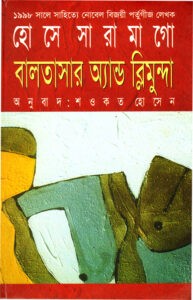
Sandesh
2005 (Translated by Saokot Hossain)
Brazil

The calligraphy on the cover is by the writer Raduan Nassar.
A brilliant reinvention of the historical novel., Convent memorial It established José Saramago internationally and made him one of the fundamental names in contemporary literature.
At the heart of this story is the construction of the National Palace of Mafra, also known as the Convent. The absolutist monarch King John V, fulfilling a promise, ordered the building to be erected at the beginning of the 18th century, in the midst of the colonial process, at the cost of an immense quantity of gold and diamonds from Brazil, as well as the blood of thousands of workers. Among them was a certain Baltasar, of the Seven-Suns lineage, crippled in his left hand after a war, and in love with Blimunda, a young woman endowed with extraordinary powers. Individuals usually overlooked by so-called official history, but who nevertheless constitute its most delicate and essential fabric.
Memorial do Convento – first published in 1982 – made the Portuguese author José Saramago an internationally acclaimed name in contemporary literature, thanks to its blend of historical narrative and individual story. Although firmly rooted in the tradition of the best fiction from his country, the work captivated readers from diverse cultures.
As in *The History of the Siege of Lisbon* and *The Stone Raft*, to cite just a few of the author's celebrated novels, the subtle irony in the observation of historical facts and the elegant fictional fabric serve a consistently brilliant, modern, and critically devastating fabulation from a social point of view. The result is a novel about the clash between the harshness of individualism and the delicacy of collective dreams. With its absolutely innovative approach to the historical novel – a genre that once served national heroes and their rigid poses – this *Memorial do Convento* recovers the illusions, fantasies, and aspirations of a Portugal that wanted to be great and eternal, even if fragile and delicate.
The calligraphy on the cover is by the writer Raduan Nassar.

At the heart of this story is the construction of the National Palace of Mafra, also known as the Convent. The absolutist monarch, King John V, fulfilling a promise, ordered the building to be erected at the beginning of the 18th century, in the midst of the colonial process, at the cost of an immense quantity of gold and diamonds from Brazil, as well as the blood of thousands of workers. Among them was a certain Baltasar, of the Seven-Suns lineage, crippled in his left hand after a war, in love with Blimunda, a young woman endowed with extraordinary powers. Individuals usually overlooked by so-called official history, but who nevertheless constitute its most delicate and essential fabric. *Memorial do Convento* – first published in 1982 – made the Portuguese author José Saramago an internationally acclaimed name in contemporary literature, thanks to its blend of historical narrative and individual story. Although firmly rooted in the tradition of the best fiction of his country, the work would captivate readers from diverse cultures. As in *The History of the Siege of Lisbon* and *The Stone Raft*, to cite just a few of the author's celebrated novels, the subtle irony in the observation of historical facts and the elegant fictional fabric serve a consistently brilliant, modern, and critically devastating fabulation from a social point of view. The result is a novel about the clash between the harshness of individualism and the delicacy of collective dreams. With its absolutely innovative approach to the historical novel – a genre that once served national heroes and their rigid poses – this *Memorial do Convento* recovers the illusions, fantasies, and aspirations of a Portugal that wanted to be great and eternal, even if fragile and delicate.
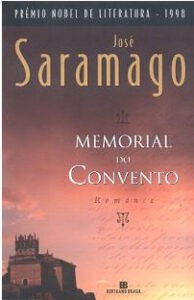
Bertrand Brasil
1987
Language
Portuguese
Bertrand Brasil
1987

Difel
1983
Language
Portuguese
Difel
1983
Bulgaria

„Възпоминание за манастира“ (1982) разкрива яркия белетристичен талант на бъдещия нобелист Жозе Сарамаго (1922-2010) и го налага като най-четения португалски писател. Романът издаден в стотици хиляди екземпляри, преведен е на десетки езици и се превръща в световен бестселър. През 1984 г. е удостоен с Голямата награда на Португалския ПЕН-клуб. Click here „Името на розата“ на Умберто Еко и с Габриел Гарсия Маркес. Фелини вижда в него потенциал за кинематографично претворяване. Here's what you can find on the операта „Балтазар и Блимунда“ на италианския композитор Азио Корги, posted in 1990 г. в „Ла Скала“.
Португалия в началото на XVIII век. Крал Жоао V дава обет пред Бога, че ще построи манастир в Мафра, ако кралицата го дари с наследник. Започва невиждан по мащабност градеж, свързан с огромни усилия и жертви, в който участват хиляди поданици от цялата страна. В същото време Балтазар Седем Слънца, еднорък войник, и Блимунда Седем Луни, жена с необикновена дарба, помагат на отец Bartolomeu Гужмао в строежа на летателна машина.
Сепична сила на словото Сарамаго пресъздава великолепието на кралския двор, ужаса на Инквизицията и суеверието на народа. Редуват се епизоди, показващи битието и обичаите на обикновените хора, религиозни процесии и аутодафета, важни моменти от живота на кралското семейство… пламенна любов между Балтазар и Блимунда.
„Възпоминание за манастира“ е роман, в който умело се преплитат исторически факти, художествена измислица и елементи на fantastic.
Блестящ… опияняващ роман…
„Ню Йорк Таймс Бук Ривю“
China
Colombia
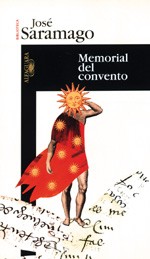
Alfaguara
2007
Language
Spanish
The construction of this novel records in its own right the historical story, which reconstructs the popular life of the time, on a tour of the different towns in the surrounding areas of Lisbon. King D. João V needed hereders and, as Doña María Ana did not conceive, he promised to build a convent in Mafra in exchange for having hereders. Simultaneously, we witness the daily life of the pueblo through the vision of a soldier who lost his left hand in the war against the Spanish. In an account of the Inquisition, Baltasar meets Blimunda, a woman with magical powers who sees inside people, and whose mother was exiled to Angola for having similar powers. Defying the rigors of religion, both get married through a blood ritual. Baltasar becomes an assistant to Father Bartolomeu, who, under the king's protection, works to invent a flying machine. The flying machine symbolizes two ideals: the cultivated, represented by Father Bartolomeu himself, and the popular, personified in Blimunda and Baltasar. Saramago gives the language of this novel to the tone of historical narrations and performs true syntactic juggling.
Korea

Print Korea Agency
1998
Language
Korean
Print Korea Agency
1998
Croatia

Bio jednom jedan kralj koji se zavjetovao podići samostan u Mafri. Bili jednom ljudi koji izgradiše taj samostan. Bio jednom vojnik bez jedne šake i žena koja je imala moći. Bio jednom svećenik koji je želio letjeti i umro poludjevši. Bilo jednom…José Saramago je dobitnik desetak nagrada i priznanja za svoj književni rad u Portugalu i izvan njega, a 1998. godine dodjeljena mu je Nobelova nagrada za književnost.
Denmark
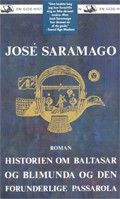
På den store kætter- og hekseafbændingsdag – vi er I Lissabon på inkvisitionens strohedstid – møder den unge, synske Blimunda tilfældigt den ludfattige soldat Balatsar Syv-Sole, der netop er vendt hjem fra krigen, hvor han har mistet sin venstre hånd. Fra samme dag lever Baltasar og Blimunda sammen. Deres kærlighed er fuldkommen. En af kirkens outsudere, pater Bartolomeu Lourenço, arbejder lidenskabeligt med alkymi og nærer en brændende drøm om at flyve. Sammen med Baltasar og Blimunda bygger han den forunderlige passerole, en maskine, der en skønne dag vil hæve sig op fra jorden og realisere pater Bartolmeus besættelse. synes at stå I telepatisk kontakt med.“
Hanne Marie Svendsen I Politiken
“"Historien om Baltasar og Blimunda og den forunderlige passerole er den føger, der er blevet oversat til dansk. Og sikke en bog! Den er en af den slags romaner man håber aldrig hører op. Den rummer ikke blot en god historie, men den er også fortalt med en intensitet, fortælleglæde og et lune, der får én til at lytte til fortællingen.”
Jens Lohmann | Information

På den store kætter- og hekseafbændingsdag – vi er I Lissabon på inkvisitionens strohedstid – møder den unge, synske Blimunda tilfældigt den ludfattige soldat Balatsar Syv-Sole, der netop er vendt hjem fra krigen, hvor han har mistet sin venstre hånd. Fra samme dag lever Baltasar og Blimunda sammen. Deres kærlighed er fuldkommen. En af kirkens outsudere, pater Bartolomeu Lourenço, arbejder lidenskabeligt med alkymi og nærer en brændende drøm om at flyve. Sammen med Baltasar og Blimunda bygger han den forunderlige passerole, en maskine, der en skønne dag vil hæve sig op fra jorden og realisere pater Bartolmeus besættelse. synes at stå I telepatisk kontakt med.“
Hanne Marie Svendsen I Politiken
“"Historien om Baltasar og Blimunda og den forunderlige passerole er den føger, der er blevet oversat til dansk. Og sikke en bog! Den er en af den slags romaner man håber aldrig hører op. Den rummer ikke blot en god historie, men den er også fortalt med en intensitet, fortælleglæde og et lune, der får én til at lytte til fortællingen.”
Jens Lohmann | Information
Slovakia

Román Baltasar a Blimunda se odehrává v 18. století: dějištěm je portugalský královský dvůr stejně jako prostředí nejchudších vrstev. Skvěle zvládnutá historická látka (vystupují tu historické postavy a glosovány jsou různé události, jako například stavba františkánského kláštera v Mafře nebo sestrojení “létajícího stroje”) se míchá s fikcí v několika dějových liniích. Tou nejdůležitější je ale příběh velké lásky dvou titlních postav… Román přibližuje praktiky církve a inkvizice a velmi ironicky proti nim vystupuje. Dílo dokáže výborně vystihnout dobovou mentalitu a fantazii, roli intuice v duchovním životě lidí, učenost, umění i magii.

Tatran
1989 (Trans.: Miroslav Lenghardt)
Language
Slovak
1989 (Trans.: Miroslav Lenghardt)
Spain
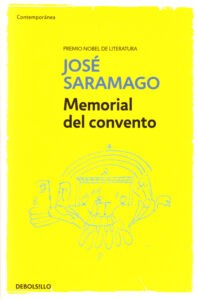
Alfaguara / Penguin Random House
2015 (DeBolsillo — Contemporary) (Trans.: Basilio Losada)
Language
Spanish
In the Convent Memorial José Saramago makes an incursion into the historical narrative.
The volume covers a period of approximately 30 years in the history of Portugal during the time of the Inquisition. The plant records in its own right the historical heritage, which reconstructs the popular life of the time, on a tour of the different towns around Lisbon.
King D. Joâo V needed hereders and, as Doña Maria Ana did not conceive, he promised to build a convent in Mafra in exchange for having hereders. Simultaneously, we witness the daily life of the pueblo through the vision of a soldier who lost his left hand in the war against the Spanish. In an account of the Inquisition, Baltasar meets Blimunda, a woman with magical powers who sees inside people, and whose mother was exiled to Angola for having similar powers. Defying the rigors of religion, both get married through a blood ritual. Baltasar becomes an assistant to Father Bartolomeu, who, under the king's protection, works to invent a flying machine. The flying machine symbolizes two ideals: the cultivated, represented by Father Bartolomeu himself, and the popular, personified in Blimunda and Baltasar.
A direct narration, without concessions, vigorous and rich. Saramago gives the language of this novel to the tone of historical narrations and performs true syntactic juggling.

Alfaguara / Penguin Random House
2011 (Saramago Library Collection) (Translated by Basilio Losada)
Language
Spanish
In the Convent Memorial José Saramago makes an incursion into the historical narrative.
The volume covers a period of approximately 30 years in the history of Portugal during the time of the Inquisition. The plant records in its own right the historical heritage, which reconstructs the popular life of the time, on a tour of the different towns around Lisbon.
King D. Joâo V needed hereders and, as Doña Maria Ana did not conceive, he promised to build a convent in Mafra in exchange for having hereders. Simultaneously, we witness the daily life of the pueblo through the vision of a soldier who lost his left hand in the war against the Spanish. In an account of the Inquisition, Baltasar meets Blimunda, a woman with magical powers who sees inside people, and whose mother was exiled to Angola for having similar powers. Defying the rigors of religion, both get married through a blood ritual. Baltasar becomes an assistant to Father Bartolomeu, who, under the king's protection, works to invent a flying machine. The flying machine symbolizes two ideals: the cultivated, represented by Father Bartolomeu himself, and the popular, personified in Blimunda and Baltasar.
A direct narration, without concessions, vigorous and rich. Saramago gives the language of this novel to the tone of historical narrations and performs true syntactic juggling.

Alfaguara / Penguin Random House
2001 (Punto de Lectura - pocket edition) (Translated by Basilio Losada)
Language
Spanish
In the Convent Memorial José Saramago makes an incursion into the historical narrative.
The volume covers a period of approximately 30 years in the history of Portugal during the time of the Inquisition. The plant records in its own right the historical heritage, which reconstructs the popular life of the time, on a tour of the different towns around Lisbon.
King D. Joâo V needed hereders and, as Doña Maria Ana did not conceive, he promised to build a convent in Mafra in exchange for having hereders. Simultaneously, we witness the daily life of the pueblo through the vision of a soldier who lost his left hand in the war against the Spanish. In an account of the Inquisition, Baltasar meets Blimunda, a woman with magical powers who sees inside people, and whose mother was exiled to Angola for having similar powers. Defying the rigors of religion, both get married through a blood ritual. Baltasar becomes an assistant to Father Bartolomeu, who, under the king's protection, works to invent a flying machine. The flying machine symbolizes two ideals: the cultivated, represented by Father Bartolomeu himself, and the popular, personified in Blimunda and Baltasar.
A direct narration, without concessions, vigorous and rich. Saramago gives the language of this novel to the tone of historical narrations and performs true syntactic juggling.

Alfaguara / Penguin Random House
1998; 2001 (Punto de Lectura - pocket edition); 2011 (Colecção Biblioteca Saramago); 2015 (De Bolsillo — Contemporánea) (Translated by Basilio Losada)
Language
Spanish
In the Convent Memorial José Saramago makes an incursion into the historical narrative.
The volume covers a period of approximately 30 years in the history of Portugal during the time of the Inquisition. The plant records in its own right the historical heritage, which reconstructs the popular life of the time, on a tour of the different towns around Lisbon.
King D. Joâo V needed hereders and, as Doña Maria Ana did not conceive, he promised to build a convent in Mafra in exchange for having hereders. Simultaneously, we witness the daily life of the pueblo through the vision of a soldier who lost his left hand in the war against the Spanish. In an account of the Inquisition, Baltasar meets Blimunda, a woman with magical powers who sees inside people, and whose mother was exiled to Angola for having similar powers. Defying the rigors of religion, both get married through a blood ritual. Baltasar becomes an assistant to Father Bartolomeu, who, under the king's protection, works to invent a flying machine. The flying machine symbolizes two ideals: the cultivated, represented by Father Bartolomeu himself, and the popular, personified in Blimunda and Baltasar.
A direct narration, without concessions, vigorous and rich. Saramago gives the language of this novel to the tone of historical narrations and performs true syntactic juggling.
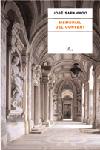
«There was a king who promised to build a convent in Mafra, on the coast of Lisbon. There were some people who built the convent. Una vegada there was a manc soldier and a woman who came inside the homes if she was in dejú. One way there was a capella that returned… Portugal, at the end of the seventeenth century, was a lot of dreams, mistery and pain. La llum i les ombres del Barroc.»

«There was a king who promised to build a convent in Mafra, on the coast of Lisbon. There were some people who built the convent. Una vegada there was a manc soldier and a woman who came inside the homes if she was in dejú. One way there was a capella that returned… Portugal, at the end of the seventeenth century, was a lot of dreams, mistery and pain. La llum i les ombres del Barroc.»
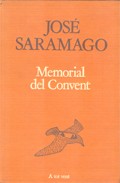
«There was a king who promised to build a convent in Mafra, on the coast of Lisbon. There were some people who built the convent. Una vegada there was a manc soldier and a woman who came inside the homes if she was in dejú. One way there was a capella that returned… Portugal, at the end of the seventeenth century, was a lot of dreams, mistery and pain. La llum i les ombres del Barroc.»
USA

From the recipient of the 1998 Nobel Prize in Literature, a “brilliant…enchanting novel” (New York Times Book Review) of romance, deceit, religion, and magic set in eighteenth-century Portugal at the height of the Inquisition. National bestseller.«Portugal. 1711. It is the time of the Inquisition, and anything can happen. Bargains are made with the Allmighty and lesser spirits… heretics are hunted with pointed precision… yet love can still bloom into a breathtaking passion plant with petals soft as a dream.
So it is for Baltasar and Blimunda. He is a man out of step with his time. She is a woman who can see into souls. They are brought together by a priest who dreams only of a fabulous flying machine. And their tragicomic efforts are buoyed heavenward by the divinely inspired music of Scarlatti and the charm of the love they share in a singularly loveless age.
An extraordinary and rich poetic tale, an outrageous novel of romance and deceit, religion and magic, Baltasar and Blimunda is an astonishing adventure into a magnificent world, caught in a tick of time, suspended on a cloud somewhere between dreams and desire.»
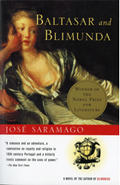
From the recipient of the 1998 Nobel Prize in Literature, a “brilliant…enchanting novel” (New York Times Book Review) of romance, deceit, religion, and magic set in eighteenth-century Portugal at the height of the Inquisition. National bestseller.«Portugal. 1711. It is the time of the Inquisition, and anything can happen. Bargains are made with the Allmighty and lesser spirits… heretics are hunted with pointed precision… yet love can still bloom into a breathtaking passion plant with petals soft as a dream.
So it is for Baltasar and Blimunda. He is a man out of step with his time. She is a woman who can see into souls. They are brought together by a priest who dreams only of a fabulous flying machine. And their tragicomic efforts are buoyed heavenward by the divinely inspired music of Scarlatti and the charm of the love they share in a singularly loveless age.
An extraordinary and rich poetic tale, an outrageous novel of romance and deceit, religion and magic, Baltasar and Blimunda is an astonishing adventure into a magnificent world, caught in a tick of time, suspended on a cloud somewhere between dreams and desire.»
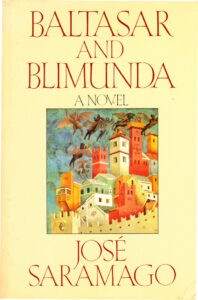
From the recipient of the 1998 Nobel Prize in Literature, a “brilliant…enchanting novel” (New York Times Book Review) of romance, deceit, religion, and magic set in eighteenth-century Portugal at the height of the Inquisition. National bestseller.«Portugal. 1711. It is the time of the Inquisition, and anything can happen. Bargains are made with the Allmighty and lesser spirits… heretics are hunted with pointed precision… yet love can still bloom into a breathtaking passion plant with petals soft as a dream.
So it is for Baltasar and Blimunda. He is a man out of step with his time. She is a woman who can see into souls. They are brought together by a priest who dreams only of a fabulous flying machine. And their tragicomic efforts are buoyed heavenward by the divinely inspired music of Scarlatti and the charm of the love they share in a singularly loveless age.
An extraordinary and rich poetic tale, an outrageous novel of romance and deceit, religion and magic, Baltasar and Blimunda is an astonishing adventure into a magnificent world, caught in a tick of time, suspended on a cloud somewhere between dreams and desire.»

From the recipient of the 1998 Nobel Prize in Literature, a “brilliant…enchanting novel” (New York Times Book Review) of romance, deceit, religion, and magic set in eighteenth-century Portugal at the height of the Inquisition. National bestseller.«Portugal. 1711. It is the time of the Inquisition, and anything can happen. Bargains are made with the Allmighty and lesser spirits… heretics are hunted with pointed precision… yet love can still bloom into a breathtaking passion plant with petals soft as a dream.
So it is for Baltasar and Blimunda. He is a man out of step with his time. She is a woman who can see into souls. They are brought together by a priest who dreams only of a fabulous flying machine. And their tragicomic efforts are buoyed heavenward by the divinely inspired music of Scarlatti and the charm of the love they share in a singularly loveless age.
An extraordinary and rich poetic tale, an outrageous novel of romance and deceit, religion and magic, Baltasar and Blimunda is an astonishing adventure into a magnificent world, caught in a tick of time, suspended on a cloud somewhere between dreams and desire.»

This collection, available exclusively in e-book form, brings together the twelve novels (and one novella) of the great Portuguese writer José Saramago, with an introductory essay by Ursula Le Guin. From Saramago's early work, like the enchanting Baltasar & Blimunda and the controversial Gospel According to Jesus Christ, through his masterpiece Blindness and its sequel Seeing, to his later fables of politics, chance, history, and love, like All the Names and Death with Interruptions, this volume showcases the range and depth of Saramago's career, his inimitable narrative voice, and his vast reserves of invention, humor, and understanding.
Finland

Verraton lukuelämys, portugalilainen menestyromaani, jossa herkän kaunista rakkaustarinaa already runollista kuvitelmaa sielujen paosta vapauteen ympäröi säälimättömän väkevä ja riemastuttavan rehevä kuvaus 1700-luvan Portugalista, ehdottoman yksinvallan ja uskonnollisen fanatismin kukois-tuksesta ja mielettömistä ilmentymistä.
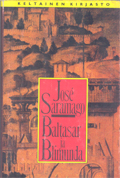
Verraton lukuelämys, portugalilainen menestyromaani, jossa herkän kaunista rakkaustarinaa already runollista kuvitelmaa sielujen paosta vapauteen ympäröi säälimättömän väkevä ja riemastuttavan rehevä kuvaus 1700-luvan Portugalista, ehdottoman yksinvallan ja uskonnollisen fanatismin kukois-tuksesta ja mielettömistä ilmentymistä.
France
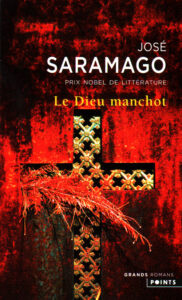
Balthazar Sept-Soleils et Blimunda Sept-Lunes, lui soldat, elle sorcière, se sont rencontrés à Lisbonne, ville des plaisirs et de la religion, des sacrifices et de la sensualité. Ils sont témoins des grands événements portugales du XVIIIe siècle: l'édification du gigantic palace-couvent à Mafra, celle de la machine steering wheel du moine Bartolomeu de Gusmäo, les bûchers de l'Inquisition, les temptations alchimiques…Epique, blasphématoire, Le Dieu manchot est une grande fable baroque sur fond d'intrigues et d'épidémies, où les opprimimés et les laissés-pour-compte sont les héros de l'Histoire.
« A chef-d'uvre marinant dans les meilleurs peppers de la tradition baroque. »
L'Express

Balthazar Sept-Soleils et Blimunda Sept-Lunes, lui soldat, elle sorcière, se sont rencontrés à Lisbonne, ville des plaisirs et de la religion, des sacrifices et de la sensualité. Ils sont témoins des grands événements portugales du XVIIIe siècle: l'édification du gigantic palace-couvent à Mafra, celle de la machine steering wheel du moine Bartolomeu de Gusmäo, les bûchers de l'Inquisition, les temptations alchimiques…Epique, blasphématoire, Le Dieu manchot est une grande fable baroque sur fond d'intrigues et d'épidémies, où les opprimimés et les laissés-pour-compte sont les héros de l'Histoire.
« A chef-d'uvre marinant dans les meilleurs peppers de la tradition baroque. »
L'Express
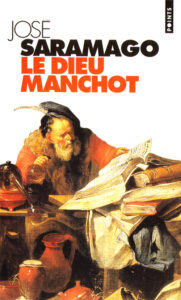
Balthazar Sept-Soleils et Blimunda Sept-Lunes, lui soldat, elle sorcière, se sont rencontrés à Lisbonne, ville des plaisirs et de la religion, des sacrifices et de la sensualité. Ils sont témoins des grands événements portugales du XVIIIe siècle: l'édification du gigantic palace-couvent à Mafra, celle de la machine steering wheel du moine Bartolomeu de Gusmäo, les bûchers de l'Inquisition, les temptations alchimiques…Epique, blasphématoire, Le Dieu manchot est une grande fable baroque sur fond d'intrigues et d'épidémies, où les opprimimés et les laissés-pour-compte sont les héros de l'Histoire.
« A chef-d'uvre marinant dans les meilleurs peppers de la tradition baroque. »
L'Express

Roman epic, fresh truculent de la cour lusitanienne in the XVllle siècle sous le règne de João V – dit le Magnanime – Le Dieu manchot nous conte les dernières heures de la splendeur du royaume portugal, juste avant le tremblement de terre qui détruisit Lisbonne en 1755. Le soldat manchot Sept-Soleils, le moine Bartolomeu de Gusmao, the sorcière voyante Blimunda, autant de personnages pittoresques évoluant autour d'un Roi malheureux de ne pouvoir assurer sa descent… Que ne faudrait-il inventer pour qu'il échappe à cette terrible malédiction ?A mi-chemin entre la fable blasphématoire et le roman history, ce Recite trace the portrait of a Portugal mythique, revisited by one of the greatest contemporary auteurs.

Roman epic, fresh truculent de la cour lusitanienne in the XVllle siècle sous le règne de João V – dit le Magnanime – Le Dieu manchot nous conte les dernières heures de la splendeur du royaume portugal, juste avant le tremblement de terre qui détruisit Lisbonne en 1755. Le soldat manchot Sept-Soleils, le moine Bartolomeu de Gusmao, the sorcière voyante Blimunda, autant de personnages pittoresques évoluant autour d'un Roi malheureux de ne pouvoir assurer sa descent… Que ne faudrait-il inventer pour qu'il échappe à cette terrible malédiction ?A mi-chemin entre la fable blasphématoire et le roman history, ce Recite trace the portrait of a Portugal mythique, revisited by one of the greatest contemporary auteurs.
Georgia

Intelekti pab
2006
Language
Georgian
Intelekti pab
2006
Greece

Ήταν μια φορά κι έναν καιρό ένας βασιλιάς που έταξε να χτίσει ένα τεράστιο μοναστήρι σε μια μικρή κωμόπολη αν ο Θεός τού έδινε διάδοχο. Ήταν μια φορά κι έναν καιρό 50,000 εργάτες που εξαναγκάστηκαν να το χτίσουν. Ήταν ακόμα ένας κουλός στρατιώτης που αγάπησε μια γυναίκα η οποία έβλεπε αυτό που δεν μπορούσε να δει κανείς. Ήταν κι ένας ιερέας-εφευρέτης που ήθελε να πετάξει, αλλά πέθανε τρελός. Ήταν μια φορά κι έναν καιρό η Ιερά Εξέταση. Κι ήταν μια φορά κι έναν καιρό, στην Πορτογαλία του 18ου αιώνα…Το Χρονικό του μοναστηριού θεωρείται ένα από τα σημαντικότερα έργα του Πορτογάλου νομπελίστα και επανεκδίδεται στα ελληνικά σε νέα μετάφραση, σύμφωνα με την επιθυμία του συγγραφέα.

Ήταν μια φορά κι έναν καιρό ένας βασιλιάς που έταξε να χτίσει ένα τεράστιο μοναστήρι σε μια μικρή κωμόπολη αν ο Θεός τού έδινε διάδοχο. Ήταν μια φορά κι έναν καιρό 50,000 εργάτες που εξαναγκάστηκαν να το χτίσουν. Ήταν ακόμα ένας κουλός στρατιώτης που αγάπησε μια γυναίκα η οποία έβλεπε αυτό που δεν μπορούσε να δει κανείς. Ήταν κι ένας ιερέας-εφευρέτης που ήθελε να πετάξει, αλλά πέθανε τρελός. Ήταν μια φορά κι έναν καιρό η Ιερά Εξέταση. Κι ήταν μια φορά κι έναν καιρό, στην Πορτογαλία του 18ου αιώνα…Το Χρονικό του μοναστηριού θεωρείται ένα από τα σημαντικότερα έργα του Πορτογάλου νομπελίστα και επανεκδίδεται στα ελληνικά σε νέα μετάφραση, σύμφωνα με την επιθυμία του συγγραφέα.
Netherlands
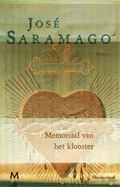
Memoriaal van het klooster wordt algemeen beschouwd als Saramago's meesterwerk. Het vertelt het verhaal van de bouw van een klooster in de achttiende eeuw. Aanleiding daarvoor was de gerarfte van Dom João V, koning van Portugal, een klooster te bouwen als er een kind geboren zou worden uit zijn huwelijk met Maria Ana van Oostenrijk. Het kind kwam er in daarmee kreeg Portugal in het plaatsje Mafra een van zijn grootste religieuze bouwwerken. Maar er is een keerzijde: jarenlang geploeter en gezwoeg, terreur van de Inquisitie, dwangarbeid, armoede en lijden van het gewone volk, kortom alle narigheid die voortkomt uit de grootheidswaan van een vorst.

Memoriaal van het klooster wordt algemeen beschouwd als Saramago's meesterwerk. Het vertelt het verhaal van de bouw van een klooster in de achttiende eeuw. Aanleiding daarvoor was de gerarfte van Dom João V, koning van Portugal, een klooster te bouwen als er een kind geboren zou worden uit zijn huwelijk met Maria Ana van Oostenrijk. Het kind kwam er in daarmee kreeg Portugal in het plaatsje Mafra een van zijn grootste religieuze bouwwerken. Maar er is een keerzijde: jarenlang geploeter en gezwoeg, terreur van de Inquisitie, dwangarbeid, armoede en lijden van het gewone volk, kortom alle narigheid die voortkomt uit de grootheidswaan van een vorst.

Arbeiderspers
1985 (Translated by Harrie Lemmens)
Language
Dutch
In Fernando Pessoa is José Saramago, geboren 1922, internationaal de beroemdste Portugese schrijver van deze eeuw. Die faam dankt hij vooral aan het uitzonderlijke succes van zijn roman Memoriaal van het klooster uit 1982, dat in Portugal zeventien maal werd herdrukt en in meer dan twintig landen is vertaald. klooster te zullen bouwen als er een kind geboren wordt uit zijn huwelijk met Maria Ana van Oostenrijk. Het kind komt er en daarmee krijgt Portugal een van zijn grootste religieuze bouwwerken in en rond het plaatsje Mafra. Hoe het klooster door middel van jarenlang gezwoeg, terreur van de Inquisitie en dwangarbeid tot stand komt, verhaalt deze roman, die in wezen een parabel is van de grootheidswaan van een vorst en van de armoede en het lijden van het volk. De roman bevat echter ook het verhaal van de bouw van een der eeste vliegtuigen van de liefdesverhouding van Baltasar en blimunda, van de bejaarde ex-soldaat João Elvas en van tal van andere curieze figuren. Een rijkgeschakeerd meeterwerk.
* Een compleet literair meesterwerk, van grote documentaire waarde en van een fonkelend fantaisisme, met dat specifieke epische realisme ook dat zich enkel laat vergelijken met het hoogste niveau van de Latijnsamerikaanse literatuur. – Tagesanzeiger
* Saramago heeft zich ten doel gesteld het genre van de historische roman spectaculair te vernieuwen en dat is hem helemaal gelukt. Dit hoogtepunt uit onze eigentijdse literatuur is een overtuigende synthse van alle literaire stromingen en tendensen in de Iberische wereld. – Nue Zürcher Zeitung
* Memorial van het klooster is of brilliant verbeelding van het achttiendeeeuwse Portual in enn intentions pakkende fabel. Irwin Stern in World Literature Today
Hungary
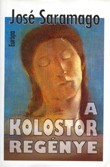
Egy félkarú katona, egy léleklátó asszony és egy repülésrõl álmodó, fantaszta szerzetes a hõse a legnagyobb elõ portugal író történelmi regényének, amelyben mese és valóság keveredik. Miközben az Inkivizíció máglyára küld mindenkit, akire az eretnekség gyanújának akár csak az árnyéka is vetül, ez ahárom ember keresztény lelkekre vadászik, hogy a segítségükkel emeljék levegõbe a brazil szerzetes repülõ szerkezetét. Földi és légi kalandjaik során bejárják egész Portugáliát, amelyet egyetlen hatalmas építõmûhellyé valltoztatott a nagyravágyó uralkodó, V. János, aki a spanyol Escorialnál és a római Szent Péter-bazilikánál is nagyobb építménnyel szerette volna beírni nevét a történelembe. A portugal író víziójában megelevenedik elõttünk a XVIII. to felvilágosodás Europe meg 1998-ban Nobel-díjat.
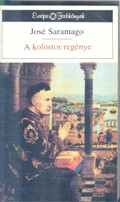
Egy félkarú katona, egy léleklátó asszony és egy repülésrõl álmodó, fantaszta szerzetes a hõse a legnagyobb elõ portugal író történelmi regényének, amelyben mese és valóság keveredik. Miközben az Inkivizíció máglyára küld mindenkit, akire az eretnekség gyanújának akár csak az árnyéka is vetül, ez ahárom ember keresztény lelkekre vadászik, hogy a segítségükkel emeljék levegõbe a brazil szerzetes repülõ szerkezetét. Földi és légi kalandjaik során bejárják egész Portugáliát, amelyet egyetlen hatalmas építõmûhellyé valltoztatott a nagyravágyó uralkodó, V. János, aki a spanyol Escorialnál és a római Szent Péter-bazilikánál is nagyobb építménnyel szerette volna beírni nevét a történelembe. A portugal író víziójában megelevenedik elõttünk a XVIII. to felvilágosodás Europe meg 1998-ban Nobel-díjat.
Israel

(מרים טבעון)]לקורא העברי צפוי בספר הזה – הראשון של סאראמאגו בעברית – מפגש המזכיר בעוצמתו את המפגש מעורר-ההשתאות עם 'מאה שנים של בדידות'. ואכן, הספר – תערובת מקורית של ריאליזם היסטורי דק-בפרטים ושל פנטסיה – הושווה לספרו של מארקס גם בביקורת. בדמיון מבריק ובהומור שוזר הספר, על רקע המאה ה-17, אירועים מחצר-המלוכה והאינקוויזיציה עם אירועים אנושיים מחיי פשוטי-העם, בארץ הנמקה ברעב ובדיכוי. במרכזו ניצבים שני ‘פרויקטים’: מלך פורטוגל, חובב הנזירוֹת, בונה מינזר מפואר, תוך שיעבוד נוראי של בני-עמו. מצד שני – הַמְראה של קידמה ודמיון יוצר: האב ברתולומאו לורנסו (דמות היסטורית!) בונה ספינת-אוויר, יחד עם חייל-לשעבר קטוע-יד, ועם אהובתו של הלה, בלימונדה. בלימונדה ניחנה בכוח להסתכל פנימה אל תוך גופם של האנשים, ולראות אף את הענן האטום שבתוכם, שהוא הרצון האנושי. היא עוברת מבית מוכה מגפה אחד לאחר, לאסוף רצונות; עד שבידה אלפיים רצונות אנושיים שבכוחם להרים את ספינת-האוויר, כי “הרצון של בני-האדם הוא שתומך בכוכבים”. זהו אם-כן ספר על הכיסופים והרצון האנושי החופשי, הממריאים אל-על מול כובד רצון-העריצים השרירותי. אבל לשני “הפרויקטים” המנוגדים יש גם צד משותף: יציאה מחיי האדם הפרטי, שיעבודם של החיים למשהו “גדול”. תחת כובד פרויקט הבנייה נלקחים האנשים מחייהם שלהם, אבל גם באלתאזאר נלקח מבלימונדה. קולו הגמיש של המספר מחליף צבעים, כזיקית; פעם הוא בלתי-מהימן בהבנתו ובערכיו, וכאילו הוא בן-התקופה, ופעם הוא בעל פרספקטיבה היסטורית, הממצה את “כל ידיעתו”. הן בתיאור מאורעות גדולים, הן בפרטי חיי-אנוש “שפלים”, והן בקטעים האירוניים על אלוהים, דמות לא-שולית בספר, זהו ספר גדול, שזכות היא להוציאו לאור. סאראמאגו, היום הבולט שבסופרי פורטוגל, נולד ב-1922 למשפחה של כפריים. את בית-הספר התיכון לא סיים, בגלל קשיים כלכליים, והיה מכונאי, שרטט וכו' ובהמשך עיתונאי ועורך. החל מ-1966 פירסם ספרי שירה, מחזות, סיפורים, רומאנים, מסות ו“כרוניקות”, ומ-1979 הוא מתמסר אך לפעילותו כסופר. 'דברי ימי מינזר' (1982) הוא ספרו פורץ-הדרך, שעימו זכה להכרה עולמית. הוא נדפס בפורטוגל בלמעלה מ-20 מהדורות, ראה-אור בתרגום ב-25 ארצות, וקיבל שורה של פרסים ספרותיים. ’אותה דרך כתיבה רבת-פיתולים, פעמים אירונית ורוננת ופעמים מקוננת ומתעלה לקרשנדו טראגי, היא הסגולה העושה את 'דברי ימי מנזר' לרומאן נפלא.” (יורם ברונובסקי)
Italy
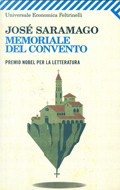
In a country dominated by the Inquisition and along the processioni funeree, incrociano i loro destini personaggi opposti e complementari: Giovanni V re di Portogallo; Father Bartolomeu Lourenco de Gusmào.che mescholastic science and mysticism in the project of vincere la gravità con una macchina per volare; Baltasar Mateus il Sette-Soli, ex-soldato monco di una mano; l'ingenua Blimunda, giovane dotata di poteri occulti che a Baltasar si lega di tenacissimo amor; and musician Domenico Scarlatti. Utopia and death, laughter and tragedy sit together in a narrative of great talent that adoperates in the record of the sacred oratorio, of the picaresque, of the comic opera and of the commedia of art to contagiously evoke the epic of the convent of Mafra: immane costruzione voluta da un monarch in exchange for her grace ricevuta for the birth dell'erede.

«In a scenario that appears to me as an attempt to become pregnant with the spouse and that chiude with the odore creates an auto-da-fé, it inscribes the vice of this prodigious, dense and spiral-shaped novel, which chorally affresses the story of the seventeenth-century Portogallo and mixes it ironically with the different way of the story. In a country dominated by the Inquisition and along the funerary process, incrociano i loro destini personaggi opposti e complementari: Giovanni V re di Portogallo; Father Bartolomeu Lourenço de Gusmão, who led the school of science and mysticism in the project of vincere la gravità con una macchina per volare; Baltasar Mateus il Sette-Soli, ex-soldato monco di una mano, e l'ingenua Blimunda, giovane dotata di poteri occulti che a lui si lega di tenacissimo amore; the musician Domenico Scarlatti. Utopia and death, laughter and tragedy sit together in a narrative of great talent that adoperates in the record of the sacred oratorio, of the picaresque, of the comic opera and of the comedy of art to contagiously evoke the epic of the convent of Mafra: immane costruzione voluta da un monarca in exchange for the grace of rice for the birth dell'erede. A corrosive mood of enlightenment and the wisdom of a strongly nineteenth-century narrative thrust, which owes a large part of his own fascination to his procedure, fanning the trascinating strength of José Saramago's art.»

«In a scenario that appears to me as an attempt to become pregnant with the spouse and that chiude with the odore creates an auto-da-fé, it inscribes the vice of this prodigious, dense and spiral-shaped novel, which chorally affresses the story of the seventeenth-century Portogallo and mixes it ironically with the different way of the story. In a country dominated by the Inquisition and along the funerary process, incrociano i loro destini personaggi opposti e complementari: Giovanni V re di Portogallo; Father Bartolomeu Lourenço de Gusmão, who led the school of science and mysticism in the project of vincere la gravità con una macchina per volare; Baltasar Mateus il Sette-Soli, ex-soldato monco di una mano, e l'ingenua Blimunda, giovane dotata di poteri occulti che a lui si lega di tenacissimo amore; the musician Domenico Scarlatti. Utopia and death, laughter and tragedy sit together in a narrative of great talent that adoperates in the record of the sacred oratorio, of the picaresque, of the comic opera and of the comedy of art to contagiously evoke the epic of the convent of Mafra: immane costruzione voluta da un monarca in exchange for the grace of rice for the birth dell'erede. A corrosive mood of enlightenment and the wisdom of a strongly nineteenth-century narrative thrust, which owes a large part of his own fascination to his procedure, fanning the trascinating strength of José Saramago's art.»
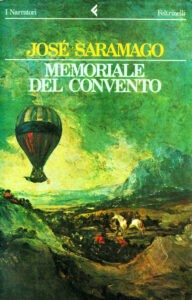
«In a scenario that appears to me as an attempt to become pregnant with the spouse and that chiude with the odore creates an auto-da-fé, it inscribes the vice of this prodigious, dense and spiral-shaped novel, which chorally affresses the story of the seventeenth-century Portogallo and mixes it ironically with the different way of the story. In a country dominated by the Inquisition and along the funerary process, incrociano i loro destini personaggi opposti e complementari: Giovanni V re di Portogallo; Father Bartolomeu Lourenço de Gusmão, who led the school of science and mysticism in the project of vincere la gravità con una macchina per volare; Baltasar Mateus il Sette-Soli, ex-soldato monco di una mano, e l'ingenua Blimunda, giovane dotata di poteri occulti che a lui si lega di tenacissimo amore; the musician Domenico Scarlatti. Utopia and death, laughter and tragedy sit together in a narrative of great talent that adoperates in the record of the sacred oratorio, of the picaresque, of the comic opera and of the comedy of art to contagiously evoke the epic of the convent of Mafra: immane costruzione voluta da un monarca in exchange for the grace of rice for the birth dell'erede. A corrosive mood of enlightenment and the wisdom of a strongly nineteenth-century narrative thrust, which owes a large part of his own fascination to his procedure, fanning the trascinating strength of José Saramago's art.»

Corriere della Sera
2014 (Trans.: Rita Desti and Carmen Radulet)
Language
Italian
With a preface by Massimo Raffaeli, included in the collection Romanzi D'Europa with the organization of Paolo Di Stefano«Il rimosoro per una vita spenta nell'indifferenza, l'accettaziones della pietas come orizzonte di ognuno: è il secret chiuso nell'architettura narrative di José Saramago.» Massimo Raffaeli
Japan

手を失った帰還兵バルタザールと不思議な力を持つブリムンダの愛の物語。国王の修道院建立、飛行機の発明、天才音楽家などが紡ぐ驚きの空想語。ノーベル賞作家の最高傑作、新訳決定版。

Jiritsu Shobo
1998
Language
Japanese
Jiritsu Shobo
1998
Macao

Macau Cultural Institute
1996 (Trans.: Fan Wei Xin)
Language
Mandarin
Macau Cultural Institute
1996 (Trans.: Fan Wei Xin)
Mexico
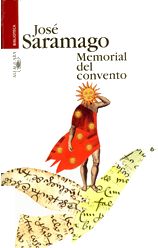
Lisbon, beginning of the 18th century. The daily life of the Portuguese court is the protagonist of this soap opera that recreates the environment full of religious prejudices of a society subjected to the nobility and the ecclesiastical hierarchy. "Let's close this door. Slowly, in a while, that our clothes can be seen as if they were desnudarían dioses. And we are not together, even humans."“
Norway

Portugal på 1700-tallet.Munken Bartolomeu har nettopp innfridd menneskets drøm om å kunne fly. Med mon på sin svimlende, altfor korte ferd har han den enarmede Baltasar og den skjønne, gåtefulle Blimunda. Den flyvende maskinen tar en runde over Mafra, der tusener av tvangsutskrevne arbeidere sliter med å reise klosteret som kong Joao V hadde lovet fransiskanerne i håp om at Herren ville skjenke ham en arving.

Portugal på 1700-tallet.Munken Bartolomeu har nettopp innfridd menneskets drøm om å kunne fly. Med mon på sin svimlende, altfor korte ferd har han den enarmede Baltasar og den skjønne, gåtefulle Blimunda. Den flyvende maskinen tar en runde over Mafra, der tusener av tvangsutskrevne arbeidere sliter med å reise klosteret som kong Joao V hadde lovet fransiskanerne i håp om at Herren ville skjenke ham en arving.
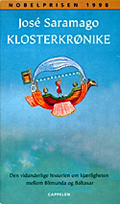
Portugal på 1700-tallet.Munken Bartolomeu har nettopp innfridd menneskets drøm om å kunne fly. Med mon på sin svimlende, altfor korte ferd har han den enarmede Baltasar og den skjønne, gåtefulle Blimunda. Den flyvende maskinen tar en runde over Mafra, der tusener av tvangsutskrevne arbeidere sliter med å reise klosteret som kong Joao V hadde lovet fransiskanerne i håp om at Herren ville skjenke ham en arving.

Portugal på 1700-tallet.Munken Bartolomeu har nettopp innfridd menneskets drøm om å kunne fly. Med mon på sin svimlende, altfor korte ferd har han den enarmede Baltasar og den skjønne, gåtefulle Blimunda. Den flyvende maskinen tar en runde over Mafra, der tusener av tvangsutskrevne arbeidere sliter med å reise klosteret som kong Joao V hadde lovet fransiskanerne i håp om at Herren ville skjenke ham en arving.
Poland
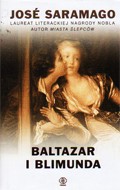
Baltazar i Blimunda wznowienie jednej z pierwszych powieści Jose Saramago, uhonorowanej prestiżową nagrodą portugalskiego PEN Clubu oraz Nagrodą Literacką Miasta Lizbona.Jan V, władca Portugalii na początku XVIII wieku, pragnie syna i ślubuje po jego narodzinach wznieść ogromny klasztor. Gdy królowa zachodzi w ciążę, przyszły ojciec, pragnąc dotrzymać obietnicy, kładzie kamień węgielny pod budowę monumentalnej bazyliki. W tym samym czasie – czasie płonących stosów inkwizycji – pewien ksiądz-heretyk realize swoje marzenie: budowę napędzanej siłą ludzkiej woli maszyny latającej, która mogłaby go przenieść do innej, szczęśliwszej krainy. W zadaniu tym pomagają mu okaleczony żołnierz Baltazar i olśniewająca Blimunda, córka zesłanej do Angoli czarownicy. Niesamowite przygody tej trójki splatają ze sobą wątek miłosny z historią o uporze człowieka walczącego o swoją godność i wolność.
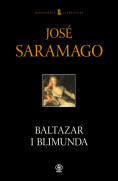
Baltazar i Blimunda wznowienie jednej z pierwszych powieści Jose Saramago, uhonorowanej prestiżową nagrodą portugalskiego PEN Clubu oraz Nagrodą Literacką Miasta Lizbona.Jan V, władca Portugalii na początku XVIII wieku, pragnie syna i ślubuje po jego narodzinach wznieść ogromny klasztor. Gdy królowa zachodzi w ciążę, przyszły ojciec, pragnąc dotrzymać obietnicy, kładzie kamień węgielny pod budowę monumentalnej bazyliki. W tym samym czasie – czasie płonących stosów inkwizycji – pewien ksiądz-heretyk realize swoje marzenie: budowę napędzanej siłą ludzkiej woli maszyny latającej, która mogłaby go przenieść do innej, szczęśliwszej krainy. W zadaniu tym pomagają mu okaleczony żołnierz Baltazar i olśniewająca Blimunda, córka zesłanej do Angoli czarownicy. Niesamowite przygody tej trójki splatają ze sobą wątek miłosny z historią o uporze człowieka walczącego o swoją godność i wolność.

Baltazar i Blimunda wznowienie jednej z pierwszych powieści Jose Saramago, uhonorowanej prestiżową nagrodą portugalskiego PEN Clubu oraz Nagrodą Literacką Miasta Lizbona.Jan V, władca Portugalii na początku XVIII wieku, pragnie syna i ślubuje po jego narodzinach wznieść ogromny klasztor. Gdy królowa zachodzi w ciążę, przyszły ojciec, pragnąc dotrzymać obietnicy, kładzie kamień węgielny pod budowę monumentalnej bazyliki. W tym samym czasie – czasie płonących stosów inkwizycji – pewien ksiądz-heretyk realize swoje marzenie: budowę napędzanej siłą ludzkiej woli maszyny latającej, która mogłaby go przenieść do innej, szczęśliwszej krainy. W zadaniu tym pomagają mu okaleczony żołnierz Baltazar i olśniewająca Blimunda, córka zesłanej do Angoli czarownicy. Niesamowite przygody tej trójki splatają ze sobą wątek miłosny z historią o uporze człowieka walczącego o swoją godność i wolność.
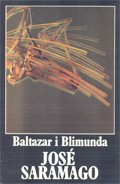
Puls
1983 (Trad.: Elżieta Milewska)
Language
Polish
Niedorozwinięty Don João V, władca kròlestwa portugalskiego u progu XVIII stulecia, za dnia bawi się zabawkami, a noce spędza na igraszkach z potulnymi zakonnicami. Król żarliwie pragnie męskiego potomka, którego Opatrzność uparcie mu odmawia. Ślubuje zatem, że jeśli małżonka-królowa obdarzy go wreszcie synem, na koszt korony wzniesie wspaniały klasztor. Za oknami pałacu płoną na stosach heretycy: trwa morderczy czas inkwizycji. Wkrótce, gdy królowa zachodzi w ciążę, rozpoczyna się mobilizacja pięćdziesięciu tysięcy niewolników potrzebnych do budowy klaszoru. Tymczasem gdzieś na uboczu pewien ksiądz-heretyk realizuje odmienne marzenie: konstruuje “wielkiego ptaka – Passarale”, maszynę do latania, która, napędzana siłą ludzkiej woli, ma go przenieść z ponurej krainy do innego, bardziej szczęśliwego świata. Dzielni jego pomagierzy to Baltazar, żołnierz pozbawiony jednej ręki, I olśniewająca piękność Blimunda, córka deportowanej do Angoli czarownicy. Niesamowite przgody księdza I niecodziennych kochanków to nie tylko opowieść o determinacji ludzkiej oraz czarodziejska bajka o miłości, to również – jak odnotował krytyk – “objawienie heroldów wolności i wolności samej na chwilę przed ich prawdziwymi narodzinami w histori”
UK

«As the Inquisition rages, an extraordinary trinity struggle to realise a creation that will fly in the face of the monstrous vanity of Church and State.In early 18th-century Lisbon, Baltasar, a soldier who has lost his left hand in battle, falls in love with Blimunda, a young girl with visionary powers. From the day he follows her home from the auto-da-fé where her mother is burned at the stake, the two are bound body and soul by a love of unassailable strength. A third party shares their supper that evening: Padre Bartolomeu Lourenço, whose fantasy is to invent a flying machine. As the Crown and the Church clash, they pursue his impossible, not to mention heretical, dream of flight.»

Jonathan Cape
1988 (Trad.: Giovanni Pontiero)
Language
English
«There has now arrived from Portugal a brilliant novel by José Saramago, a writer who is highly regarded in Portuguese-speaking countries… Much reverberates in memory after reading this enchanting novel, but most of all the love story which soars over the rest of the action like a flute across a heavy orchestra.»
Irving Howe, New York Times Book Review

Picador
1985 (Trad.: Giovanni Pontiero)
Language
English
Picador
1985 (Trad.: Giovanni Pontiero)
Romania
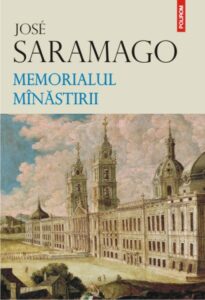
„Memorialul minastirii este o fictiune despre un anumit timp din trecut, vazut insa din perspectiva momentului in care se afla autorul, inclusiv cu tot ceea ce autorul este si are: educatia lui, interpretarea lui in ce priveste lumea, modul in care intelege procesul de transformare a societatilor. Toate acestea vazute in lumina timpului in care traieste el, fara sa existe preocuparea de a pune in lumina ceea ce focarele trecutului au clarificat deja.” (Jose Saramago)
„Saramago ne-a oferit o carte care, desi profund inradacinata in istoria tarii sale, atinge dimensiuni mistice. Este un roman de dragoste si aventura, o meditatie amara despre rolul monarhiei si al bisericii in Portugalia secolului XVIII si un comentariu ironic asupra mastilor puterii.” (The New York Times)
„Amestecul de evenimente istorice si fictionale din care este compus romanul lui Saramago aminteste de realismul magic al lui Márquez si al altor scriitori asemenea lui; rezultatul este un portret rafinat si suprarealist al vietii cotidiene din Portugalia secolului XVIII. Aceasta sumbra meditatie filosofica dovedeste pe deplin talentul celui mai important scriitor portughez al zilelor noastre.” (Publishers Weekly)
„Tonul detasat si ironic al romanului lui Saramago ar putea servi drept ilustratie a celebrei afirmatii a lui Horace Walpole: «Lumea este o comedie pentru cei care gindesc si o tragedie pentru cei care simt».” (Library Journal)

Polirom
2007 (Trad.: Mioara Caragea)
Language
Romanian
„Memorialul minastirii este o fictiune despre un anumit timp din trecut, vazut insa din perspectiva momentului in care se afla autorul, inclusiv cu tot ceea ce autorul este si are: educatia lui, interpretarea lui in ce priveste lumea, modul in care intelege procesul de transformare a societatilor. Toate acestea vazute in lumina timpului in care traieste el, fara sa existe preocuparea de a pune in lumina ceea ce focarele trecutului au clarificat deja.” (Jose Saramago)
„Saramago ne-a oferit o carte care, desi profund inradacinata in istoria tarii sale, atinge dimensiuni mistice. Este un roman de dragoste si aventura, o meditatie amara despre rolul monarhiei si al bisericii in Portugalia secolului XVIII si un comentariu ironic asupra mastilor puterii.” (The New York Times)
„Amestecul de evenimente istorice si fictionale din care este compus romanul lui Saramago aminteste de realismul magic al lui Márquez si al altor scriitori asemenea lui; rezultatul este un portret rafinat si suprarealist al vietii cotidiene din Portugalia secolului XVIII. Aceasta sumbra meditatie filosofica dovedeste pe deplin talentul celui mai important scriitor portughez al zilelor noastre.” (Publishers Weekly)
„Tonul detasat si ironic al romanului lui Saramago ar putea servi drept ilustratie a celebrei afirmatii a lui Horace Walpole: «Lumea este o comedie pentru cei care gindesc si o tragedie pentru cei care simt».” (Library Journal)
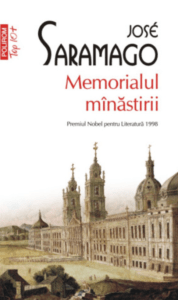
Memorialul mânăstirii are ca punct de plecare Portugalia secolului al XVIII-lea, un regat scăldat în bogăţii şi înţesat de biserici. Este perioada Inchiziţiei, a autodafeurilor, a epidemiilor de ciumă şi a marii expansiuni coloniale. Cele două personaje principale – Baltasar Şapte-Sori, un soldat abia întors de pe câmpul de luptă, şi Blimunda, o tânără care are darul clarviziunii – sunt alese de părintele Bartolomeu Lourenço să-l ajute la construirea „păsăroiului”, un aparat de zbor. Invenţia preotului se dovedeşte reuşită, însă va avea consecinţe dramatice asupra tuturor celor implicaţi în realizarea ei. Bazat pe evenimente reale, printre care se numără şi ridicarea uriaşei mânăstiri din Mafra, acest roman, ca toate cărţile lui Saramago, depăşeşte limitele istoriei, preschimbându-se într-o parabolă complexă a existenţei umane şi a eternei lupte pentru dragoste, cunoaştere şi putere.

Univers
1998 (Trad.: Mioara Caragea)
Language
Romanian
«A fost odată un rege care a făgăduit să înalţe o mînăstire în Mafra. A fost odată lumea care a construit această mînăstire. A fost odată un soldat ciung şi o femeie care avea puteri fantastice. A fost odată un preot care voia să zboare şi a murit nebun. A fost odată.»José Saramago
«Scopul ficţiunii lui Saramago, scopul oricărei ficţiuni, nu este de a zbura, de a se înălţa plutind în realităţi magice sau în ceruri inexistente, ci de a se desprinde de realitatea umană, apăsătoare, obscură, opacă, pentru a vedea mai bine sau în alt fel lumina originară ce se ascunde în fiecare om, lumină care e, poate, propria noastră beznă.»
Eduardo Lourenço
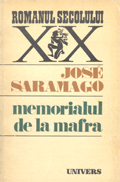
Univers
1998 (Trad.: Mioara Caragea)
Language
Romanian
«A fost odată un rege care a făgăduit să înalţe o mînăstire în Mafra. A fost odată lumea care a construit această mînăstire. A fost odată un soldat ciung şi o femeie care avea puteri fantastice. A fost odată un preot care voia să zboare şi a murit nebun. A fost odată.»José Saramago
«Scopul ficţiunii lui Saramago, scopul oricărei ficţiuni, nu este de a zbura, de a se înălţa plutind în realităţi magice sau în ceruri inexistente, ci de a se desprinde de realitatea umană, apăsătoare, obscură, opacă, pentru a vedea mai bine sau în alt fel lumina originară ce se ascunde în fiecare om, lumină care e, poate, propria noastră beznă.»
Eduardo Lourenço
Russia
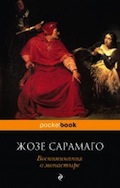
“Воспоминания о монастыре” принято сравнивать с выпущенным в то же время “Именем розы” Умберто Эко; роман Сарамаго также был переведен на десятки языков и стал международным бестселлером, более того – именно за него в 1998 году Сарамаго получил Нобелевскую премию. На фоне средневековой Португалии разворачивается эпическая история любви Бальтазара Семь Солнц и Блимунды Семь Лун, “ибо давно сказано: где есть солнце, должна быть луна, потому что только гармоничное сочетание того и другого, именуемое любовью, делает нашу землю пригодной для обитания”. Федерико Феллини говорил, что это один из самых интересных романов, которые ему приходилось читать, и планировал экранизацию “Воспоминаний…” – увы, несостоявшуюся. А в 1990 году по “Воспоминаниям…” в миланском театре “Ла Скала” была поставлена опера “Бальтазар и Блимунда”.
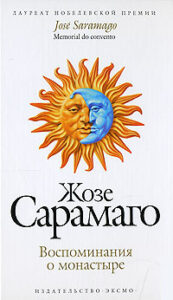
Eksmo
2008; 2010
Language
Russian
“Воспоминания о монастыре” принято сравнивать с выпущенным в то же время “Именем розы” Умберто Эко; роман Сарамаго также был переведен на десятки языков и стал международным бестселлером, более того – именно за него в 1998 году Сарамаго получил Нобелевскую премию. На фоне средневековой Португалии разворачивается эпическая история любви Бальтазара Семь Солнц и Блимунды Семь Лун, “ибо давно сказано: где есть солнце, должна быть луна, потому что только гармоничное сочетание того и другого, именуемое любовью, делает нашу землю пригодной для обитания”. Федерико Феллини говорил, что это один из самых интересных романов, которые ему приходилось читать, и планировал экранизацию “Воспоминаний…” – увы, несостоявшуюся. А в 1990 году по “Воспоминаниям…” в миланском театре “Ла Скала” была поставлена опера “Бальтазар и Блимунда”.
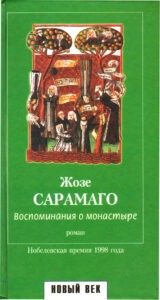
Португальский писатель Жозе Сарамаго после блестящего писательского дебюта в 1947 году вдруг замолчал на десятилетия. Критики успели забыть о его существовании, причислив к жертвам салазаровской цензуры. Но после революции 1974 года Сарамаго публикует одно произведение за другим, каждый раз вызывая фурор в среде читающей публики.Роман “Воспоминания о монастыре” переведен в 30 странах мира, он принес писателю мировую известность. В 1998 году Сарамаго был удостоен Нобелевской премии по литературе.
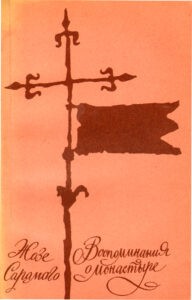
Paдуга
1985 (Trad.A. M. Kocc)
Language
Russian
Paдуга
1985 (Trad.A. M. Kocc)
Serbia
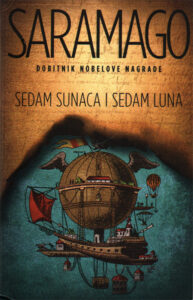
Bio jednom jedan kralj koji je obećao da će podići manastir. Bio jednom jedan sveštenik koji je želeo da leti.Sedam Sunaca i Sedam Luna je roman koji je proslavio Žozea Saramaga širom sveta. Poigravajući se istorijskim činjenicama i fikcijom, u stilu majstora magijskog realiz
Sweden
Taiwan
Turkey
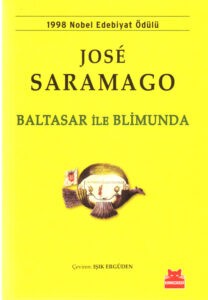
18. yüzyılda, savaşların ve salgın hastalıkların sarstığı Portekiz’de geçen Baltasar ile Blimunda’da, Nobel ödüllü yazar José Saramago, etkileyici bir aşkı anlatırken tarihsel gerçeklerle dokunmuş iki farklı hikâyeyi de romana ustalıkla katıyor: Bekledikleri veliahtın doğumunu kutlamak için manastır inşa ettiren kraliyet ailesi; insanın uçmasını sağlayacak ilk aleti, Passarola’yı yapmaya çalışan Peder Bartolomeu; ve iki âşık: sol kolunu savaşta kaybeden Baltasar ile sıradan insanların göremediklerini görebilen, annesi cadı diye engizisyon tarafından yakılan güzel Blimunda. İktidarın projesi olan Mafra Manastırı ile insan iradesinin projesi olan Passarola da romanın iki önemli kahramanı olarak öne çıkıyor. Deha ile çılgınlık arasındaki ince çizgiyi gösteren ve gerçek olayları büyülü bir anlatımın içinde yoğuran Baltasar ile Blimunda, zekâ ve heyecan dolu, unutulmaz bir başyapıt. José Saramago, ustalıklı kurgusu, yoğun ironisi ve karakterlerinin felsefi sorgulamalarıyla, okurlarına bir şölen hazırlamış. Işık Ergüden’in usta işi çevirisiyle.

18. yüzyılda, savaşların ve salgın hastalıkların sarstığı Portekiz krallığında geçen Manastır Güncesi’nde, Nobel ödüllü yazar José Saramago, etkileyici bir aşkı anlatırken tarihsel gerçeklerle dokunmuş iki farklı hikâyeyi de romana ustalıkla katıyor. Bekledikleri veliaht doğduğu takdirde Mafra’da bir manastır inşa ettirme sözü veren Kraliyet ailesi; insanın uçmasını sağlayacak ilk aleti, Passarola’yı yapmaya çalışan Peder Bartolomeu Lourenço; ve iki âşık: sol kolunu savaşta kaybeden Baltasar ile gözleri sıradan insanların göremediği derinlikleri
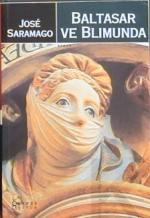
18. yüzyıl Portekizi`nin gizemli dünyasında geçen bu romanda, savaşta sol elini kaybetmiş bir er olan Balthazar ile dünyada herkesten fazla şey görebilen Blimunda adlı bir kadının aşkı, dev bir manastır ile birlikte inşa edilir. Manastırı inşa ettiren Kral V. Dom Joao`nun hınzırlığına bile de kuşlardan yükseğe uçup Tanrı`ya ulaşmaya niyet etmiş bir rahibin, Padre Bartolomeu Lourenço`nun, günahkar ruhu eklenince işler iyice sarpa sarar. Rahip bu amacına ulaşmak için uçan bir aygıt icad eder. Rahibin icad ettiği bu aygıtın adı Passarola`dır. Passarola, Baltasar, Blimunda ve Padre Bartolomeu Lourenço`yu sonsuza dek dost kılacaktır. Yıldızları gökte tutanın insan iradesi olup olmadığını merak edenler Saramago`nun yanıtına kulak vermeli.


